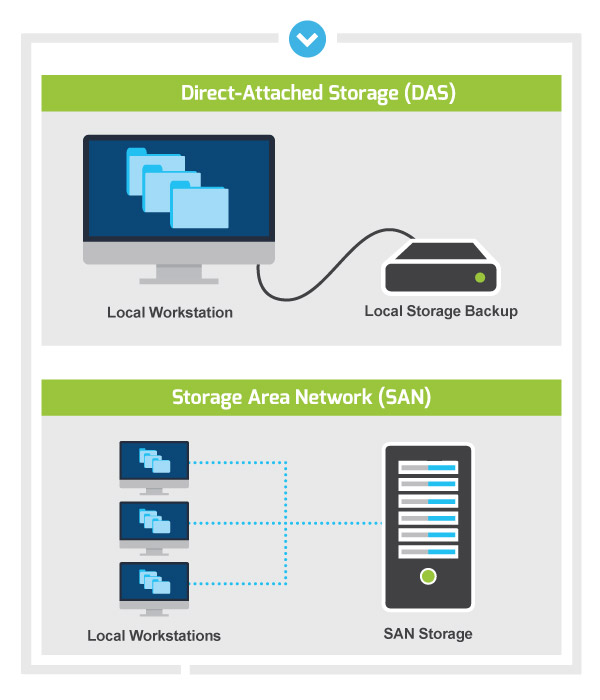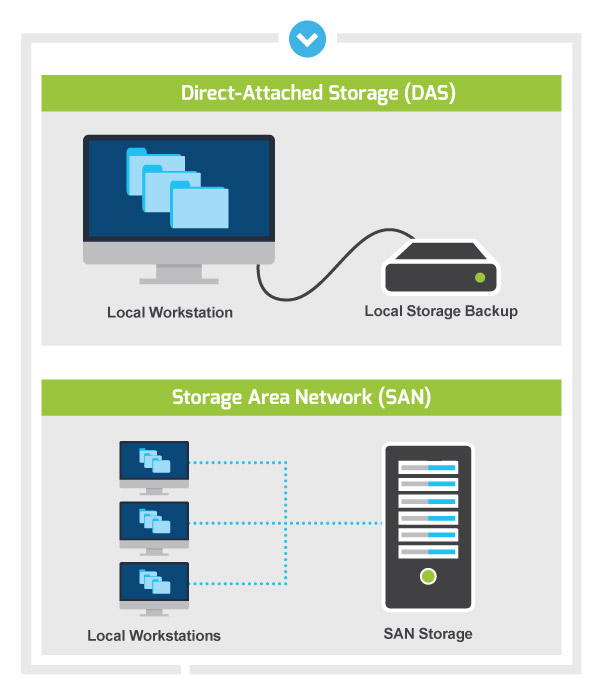A Storage Area Network (or SAN) is a high-speed network of devices that allows multiple users to store and access data apart from local machines.
Those racks of blinking boxes used in data centers? Those are SANs. They are key in virtualization, and can make a world of difference for a company’s security, performance, productivity and cost efficiency.
Do you need a SAN?
You may want to think about using a SAN if you answer “yes” to any of the following:
- Does your company have many users on a network sharing files?
- Would your business be devastated if you lost those files?
- Do you need more reliable backup and recovery options?
The old model of saving important data to local machines or Direct-Attached Storage (DAS) devices like external hard drives and flash drives has problems. When files are locked up in individual user devices, they’re difficult to share and manage. If the devices crashes, data is lost. Saving locally is also a waste of space, since each device needs to maintain a large enough hard drive to accommodate future files.
With a SAN, however, users access files over a shared network. Server space is communal, cutting down on overall space requirements. If one server goes down, another will handle its workload invisibly. Companies can have the option to virtualize desktops and seamlessly get back to work following a major location-specific outage or disaster.
In all, SANs help businesses run smoothly, with more security redundancy and better productivity. They help give your company more opportunity to grow and function as a modern, enterprise-level business.
Take a cold, hard look at your business needs.
On board with getting a SAN? Before you look at another catalog, you need to understand your environment, your business, and what your current needs are and your future 
A good place to start is with an assessment by a reputable IT team. They’ll be able to tell you how much data you’re currently dealing with, how fast you need your servers and which programs or databases will need special treatment.
This information, combined with projections of growth over the next few years can help you get a good picture of the capability you’ll need now and in the future. Once you understand your environment well enough, you’ll be able to purchase equipment and space that will enable you to get the most out of a SAN.
Get References
Before you buy, you’ll want to speak to multiple vendors. Whether you’re buying equipment or just looking for a reliable host, you’ll want to get several quotes and references. You’ll make sure to weed out any duds and get a better picture of the options that are out there.
You’ll obviously want to go with a vendor that you can trust to know what your needs are, keep your interests at the forefront of any decision and know the right questions to ask.
Get the right gear
There is a wide range of equipment brands, capabilities and prices. Typically the larger and more expensive models will have more bells and whistles. That’s fine — you may need a bell or two. Your vendor contact (see above) is there to help you get what you need without overspending.
For equipment brands, the major players (Dell, HP, Cisco) as a rule can be trusted to perform reliably and without complaint. Make sure to spare a thought for your switches as well. Moving to a more virtual storage arrangement will undoubtedly place higher strain on your existing switches, and managing that traffic will be key. There’s no bummer like beefing up your virtual servers, only to discover your local network can’t handle the traffic.
hire a data center or Buy your own?
If you’re serious about installing your own SAN, you need to take a hard look at the cost benefit of purchasing your own versus enlisting the help of a third party.
The cost of purchasing your own depends on your business’s size. For a smaller SAN, you’ll start by purchasing a network array with at least two drives, a couple extra network cards per server, two or more ethernet switches, and all the cabling required to link everything up. Then you’ll get to work hooking up and configuring the drives and all the local devices that will access your storage network.
A small SAN like this will probably run around $20,000 in equipment costs, which may be more than a small to medium-sized business expects to spend on storage. Compare that figure to what a third-party data center may charge per month. Most of the time (unless you’re running a monster business) it’s probably a smart investment to rent space in a data center, which can give you all the capability of a local SAN at a much lower expense, and still provide an option of purchasing your own down the road should your business needs and strategy point in that direction.
Interested in a reliable data center option? Contact us about Dynamic Quest’s SSAE16 II data-centers.
Want some help determining your hardware needs?
